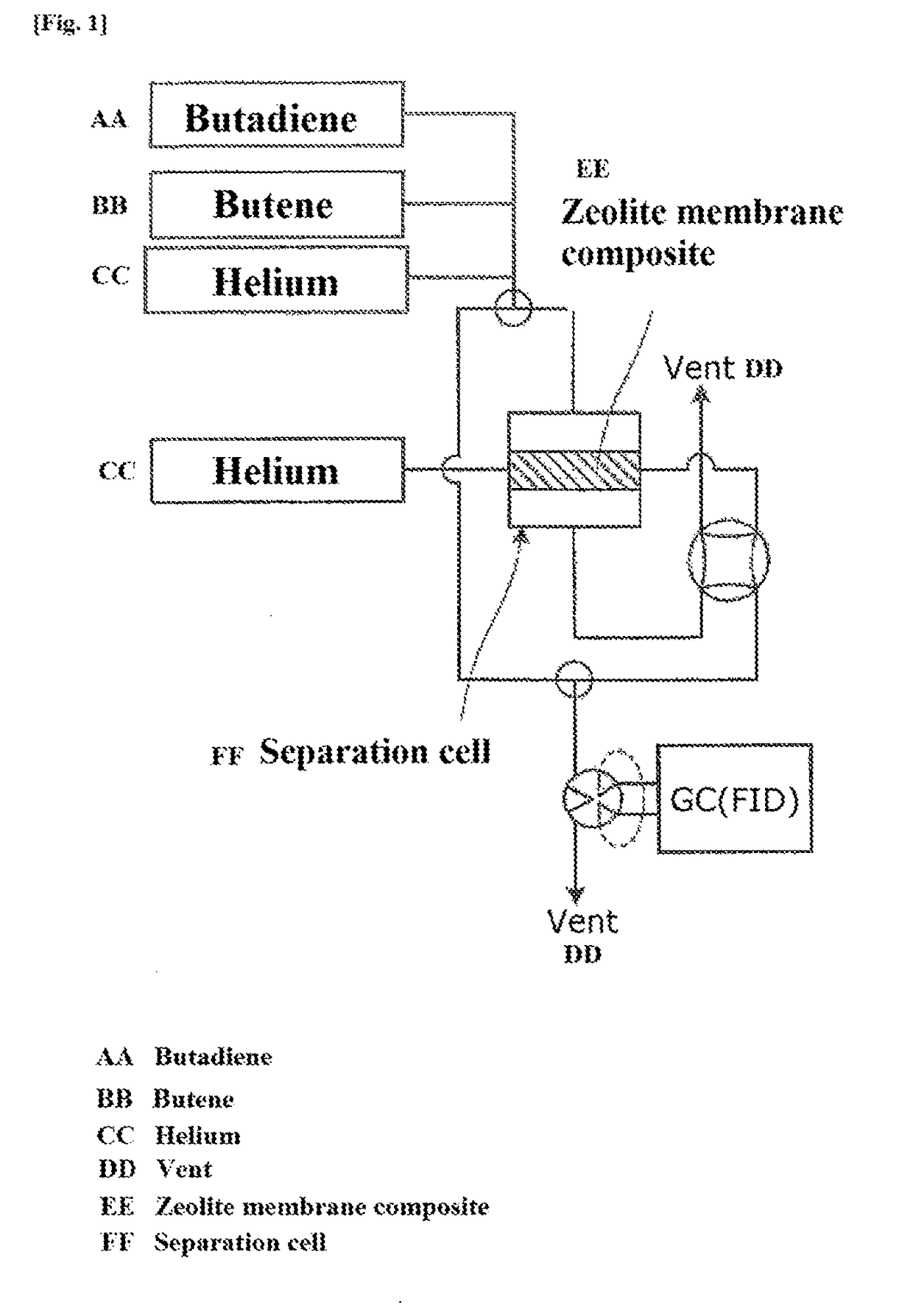Method for separating straight-chain conjugated diene
a technology of inorganic membrane and diene, which is applied in the direction of crystalline aluminosilicate zeolites, separation processes, organic chemistry, etc., can solve the problems of large amount of energy required, restrictive application scope of objects intended to be separated and condensed, and deterioration in performance, etc., to achieve high purity and efficiency
- Summary
- Abstract
- Description
- Claims
- Application Information
AI Technical Summary
Benefits of technology
Problems solved by technology
Method used
Image
Examples
example 1
[0091](a) Preparation of Porous Support with Seed Crystal Attached Thereto
[0092]A seed crystal that is a commercially available USY zeolite powder (Si / Al=7, manufactured by Tosoh Corporation) was prepared and wet-milled with a ball mill. The average particle diameter of the USY zeolite after milled was measured and found to be 200 nm. Addition of water to the milled USY zeolite was followed by stirring and centrifugal separation at 4,000 rpm for 10 minutes. After supernatant was skimmed, seed crystal slurry 1 was prepared so that the concentration of the seed crystal therein was 2.5 g / L. Next, a cylindrical α-alumina support with a 1 cm diameter and a 3 cm length was prepared as a porous support. The average pore diameter and porosity of the support were 150 nm and 37%, respectively. The α-alumina support was immersed in the seed crystal slurry for 3 minutes thereby producing seed crystal-attached porous support 1. The amount of the seed crystal supported on the porous support 1 was...
example 2
[0095]Na zeolite membrane complex 1 produced in the same manner as Example 1 was immersed in an aqueous solution of 0.01 M of rubidium nitrate under reduced pressure for one hour and then washed repeatedly with distilled water and dried at room temperature under reduced pressure thereby producing a Rb zeolite membrane complex. The resulting Rb zeolite membrane complex is a Rb—Na complex X-type zeolite, and the ratios of Rb and Na in the zeolite were 8.75 percent by mass and 10.3 percent by mass, respectively, and the molar ratio of Rb and Na was Rb / Na=0.23 mol / mol. The amount of Rb in the zeolite was calculated from the Na concentration in the rubidium nitrate aqueous solution measured using ICP after cation exchange.
example 3
[0096]Na zeolite membrane complex 1 produced in the same manner as Example 1 was immersed in an aqueous solution of 0.01 M of cesium nitrate under reduced pressure for one hour and then washed repeatedly with distilled water and dried at room temperature under reduced pressure thereby producing Cs zeolite membrane complex 1. The resulting Cs zeolite membrane complex 1 is a Cs—Na complex X-type zeolite, and the ratios of Cs and Na in the zeolite were 11.5 percent by mass and 10.3 percent by mass, respectively, and the molar ratio of Cs and Na was Cs / Na=0.19 mol / mol. The amount of Cs in the zeolite was calculated from the Na concentration in the cesium nitrate aqueous solution measured using ICP after cation exchange.
PUM
| Property | Measurement | Unit |
|---|---|---|
| Temperature | aaaaa | aaaaa |
| Molar ratio | aaaaa | aaaaa |
Abstract
Description
Claims
Application Information
 Login to View More
Login to View More - R&D
- Intellectual Property
- Life Sciences
- Materials
- Tech Scout
- Unparalleled Data Quality
- Higher Quality Content
- 60% Fewer Hallucinations
Browse by: Latest US Patents, China's latest patents, Technical Efficacy Thesaurus, Application Domain, Technology Topic, Popular Technical Reports.
© 2025 PatSnap. All rights reserved.Legal|Privacy policy|Modern Slavery Act Transparency Statement|Sitemap|About US| Contact US: help@patsnap.com


